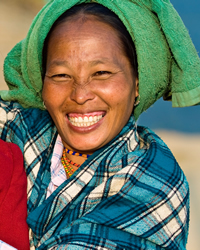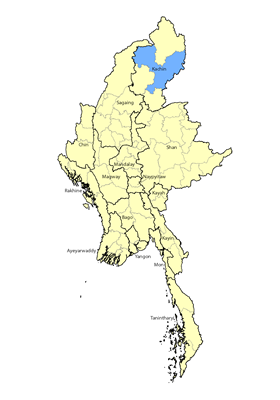In the past, the group in Myanmar were called “Heimi” by some researchers to differentiate them from the related Naga tribes in the area. Some linguists and ethnographers divided them into three categories of Eastern, Western, and Northern Heimi according to differences they saw in customs and dialect.
Location: The Gaqchan are one of only six of these tribes that are located outside the Sagaing Region in northwest Myanmar. Instead, they live in villages nestled among low hills near the town of Shinbwiyan in north Myanmar’s Kachin State. The area contains Burmese, Kachin Jingpo, Lisu, and other ethnic groups. As grinding poverty, war, and the lack of available land in the rugged mountains made life increasingly difficult in Sagaing, Shinbwiyan become a popular place for people to migrate to due to its relatively easy access and available land. In 2013, a team of linguists found that 53 out of 91 people they interviewed in Shinbwiyan were born in the mountains of Nanyun before they relocated to Shinbwiyan in recent decades.
Language: A linguistic study found that the Gaqchan dialect is related to four other varieties (Khalak, Lakki, Lungkhi, and Shangti), all of which have been profiled separately in Operation Myanmar. All these tribes live in the Shinbwiyan area and have expressed an interest in developing their own combined Bible translation team, which they would name after the Lungkhi group.2 For the time being, the Gaqchan remain a people without a written language.
Shinbwiyan is one of the locations where the most incredible engineering projects in history occurred when the Allied Forces constructed the Stillwell Road during the Second World War, creating an overland route from India to China designed to transport supplies to help the Chinese resist the advancing Japanese. The 1,072-mile (1,726-km) road cut through some of the most inhospitable terrain on earth, with mountains “as high as 4,600 feet (1,400 meters)…steep gradients, hairpin curves and sheer drops of 200 feet (60 meters), all surrounded by a thick rain forest.” After more than 1,100 Americans and countless locals perished during its construction, the project was nicknamed “A Man a Mile.” A film was released in 1945 to celebrate the completion of the engineering marvel, which was narrated by a young actor named Ronald Reagan. Today, much of the Stillwell Road has been reclaimed by jungle, and the Gaqchan and other people ride motorbikes on parts of it to get around.
Although most Gaqchan people today grow their own food and raise chickens and livestock, in the past it was said that “Most enjoy hunting as a sport as well as a means of obtaining meat. They hunt tigers, leopards, and wild boar with guns and spears, aided by dogs. Traps are used for small animals and birds, but the hunting of elephants in pitfalls has been outlawed.”
When they lived in Sagaing, all Gaqchan people were Christians, but since moving to their current location, about 20 percent are believed to have converted to Buddhism. Most Gaqchan families remain Christians, however, having been influenced by Kachin Jingpo believers in the area who have tried to share the Word of God with them despite their language differences.
These tribes in Myanmar are waiting for Bibles in their native tongues, but the linguistic complexity among them means that between 12 and 15 different Bible translations would be needed to try to cover their basic dialect affinity groups. Even then, many of the vernaculars within those clusters have significant vocabulary differences that would require compromise to arrive at a standard translation that would be suitable for all.
Scripture Prayers for the Gaqchan in Myanmar (Burma).
| Profile Source: Asia Harvest |











